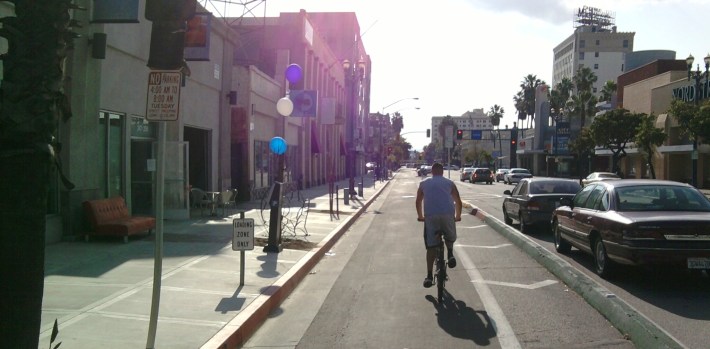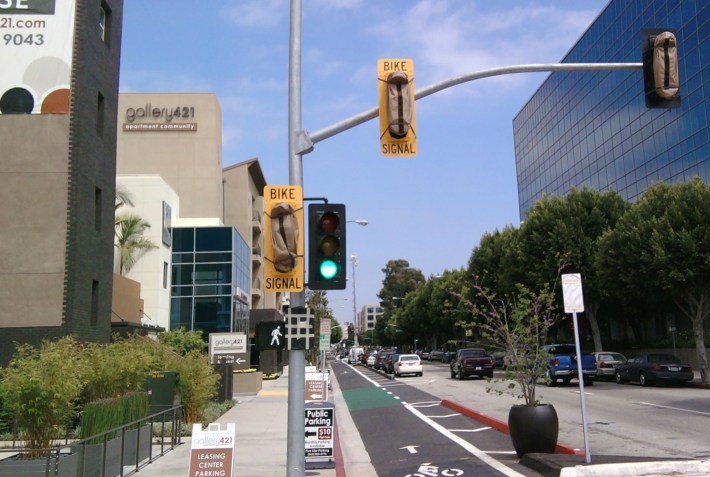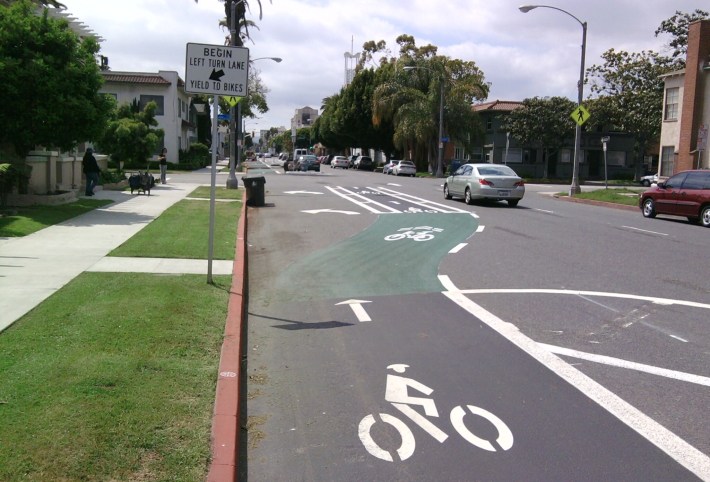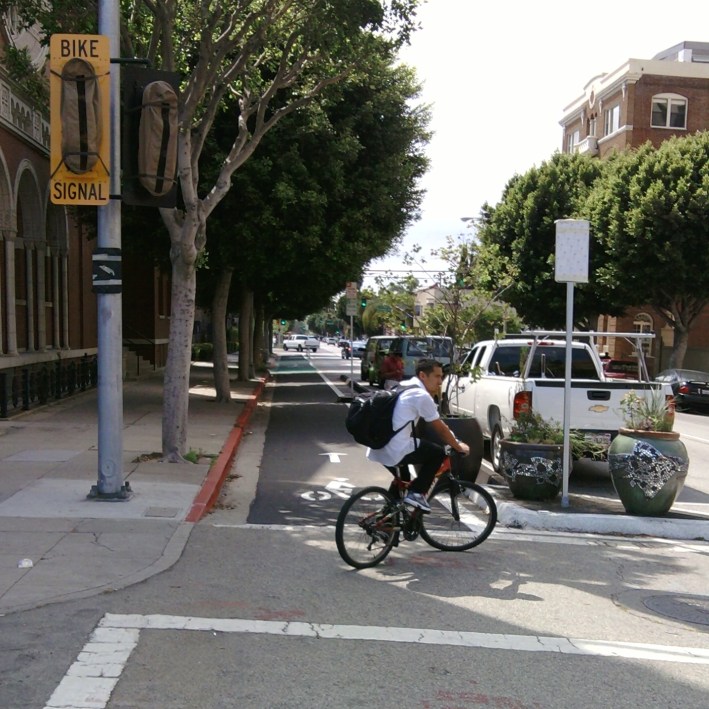Another Wonderful Long Beach First: Protected Bike Lanes
9:33 AM PDT on April 21, 2011
The city of Long Beach is Southern California's undisputed leader in innovative infrastructure for safe and convenient bicycling. They're at it again this Saturday, April 23rd 2011, when they unveil the first genuine protected bike lanes west of New York City.
Opening festivities are from 11am to 2pm at the The Promenade - one block east of Pine Avenue. The dedication ceremony takes place at 12noon. Presiding over the event will be the leadership that brought this project to fruition: Long Beach Mayor Bob Foster, Vice Mayor Suja Lowenthal, City Councilmember Robert Garcia, Mobility Coordinator Charlie Gandy and Transportation rain-maker Sumi Gant. Additional details on event flier.
In the past couple years, Long Beach has implemented the United States' second green sharrow lanes, Southern California's first green bike boxes, and L.A. County's first bicycle boulevard and first bike corral. Conventional bike lanes are becoming more and more common there. Playful bike parking hitching posts are ubiquitous in business districts. All this has contributed to bicycling becoming noticeably very common for all kinds of Long Beach residents: elderly, middle-aged, young, students, laborers, immigrants, citizens, Latinos, African-Americans, women and men, thin and not-so-thin. Sure there are still lots of cars, and some bicyclists still ride on the sidewalk, but the bicycle is visibly part of the fabric of urban Long Beach.
All that bike-wonderfulness takes a great step forward this week.
For readers unfamiliar with protected lanes (that would likely be most Angelenos), also called cycletracks or physically separated bike lanes or separated bikeways, they're a roadway treatment that provides a buffer - an actual curb - between cyclists and car traffic. While popular and common in much of Europe and Canada and South America, these facilities are only beginning to be embraced in the United States. The basic concept is to take the on-street bike lane and swap it with the parking lane - so parked cars (and typically a small curb) protect the cyclists from adjacent traffic. The cross-section is: sidewalk, bike lane, parking lane, traffic lane. A Streetfilm is worth more than a thousand words - to see protected lanes in action, watch Ninth Avenue Gets a Physically Separated Bike Lane (or the longer Physically Separated Bike Lanes.)
Protected bike lanes are for everyone, but do have great appeal to less intrepid cyclists - who can include novices, families and many women. Note that, despite their excellent safety record around the globe, cycletracks are not included in the United States' car-centric officially-approved standard facilities (called the MUTCD - Manual on Uniform Traffic Control Devices.) Long Beach sought and received Federal Highway Administration permission for an experimental facility. In this federal program, municipalities propose innovations (or at least non-U.S.-standard facilities), and the federal government approves and shields the locals from liability risks.
Long Beach's new separated bike lanes occupy the left lane of a paired couplet of east-west one-way streets crossing downtown Long Beach. The streets are Broadway and Third Street. Both facilities extend from Golden Avenue (immediately east of the 710 Freeway) to Alamitos Avenue. Each is just over one mile long.
The cycletrack project subjected these streets to a road diet, reducing them from three car travel lanes to two. Nearly all of the on-street parking has been preserved - though a handful of parking spaces (approximately 20 out of several hundred) were lost in the reconfiguration. Conventional parking meters have been replaced by electronic parking kiosks.
The project cost about $800,000 - entirely paid for by developer impact fees. Approximately 90% of the project's construction cost went to installing bike signals. You read that right: bike signals! Yes - bike traffic lights! Dozens of them. At intersections, left-turning cars cross the path of the cycletracks. To avoid collisions, bikes and left-turning-cars are given separate signal phases. Bikes go first, at a bike signal green light phase, coinciding with the green phase for proceeding straight. Cars turn left during a second phase - where they receive the left turn green arrow.
The bike signals (bright yellow and proclaiming BIKE SIGNAL) have been installed, and are planned to be turned on today, Thursday, April 21st. The cycletracks have been in place for nearly a month. As visible in the accompanying photos, they're definitely already in use. Despite the left-turn conflicts, there have been no incidents/collisions reported - according to Mobility Coordinator Charlie Gandy.
One concern commonly expressed regarding cycletracks is that where a protected facility crosses a driveway (or alley, or other unsignalized intersection) there is a likelihood of car-bike collisions, especially for novice cyclists who may think they're securely away from all traffic. Though the Long Beach facilities are downtown, and don't have huge suburban quantities of driveways, they definitely intersect with driveways and alleys, and even one unsignalized cross-street: Lime Avenue.
Long Beach has used color to draw attention to alert cyclists and drivers to the potential conflict in these zones. They're painted green!
At the unsignalized intersection at Lime Avenue, the bike lane veers (or weaves) to the right, allowing cars to merge and turn left from the left lane. This treatment is bit less than optimal; it creates an additional point of potential bike-car conflict prior to the intersection - as compared to the bike signal treatment, where the only potential conflict is at the actual intersection (and that conflict is eliminated by separate signal phases.) Long Beach has minimized these weave treatments. Where there are about three dozen bike-signalized intersections, there are only five of these of these "weaves."
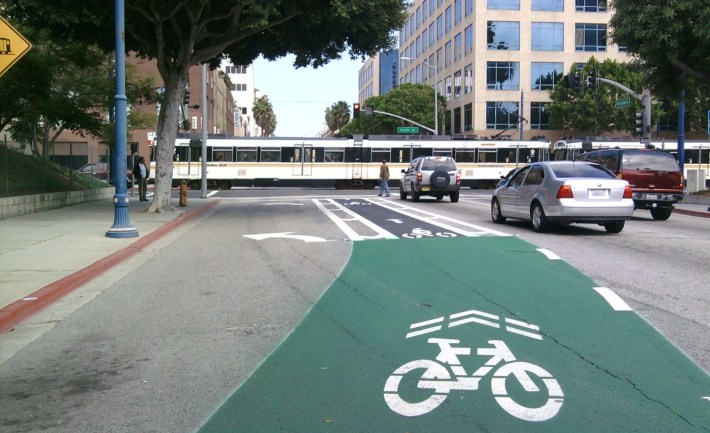
As mentioned, one of the weaves is at Lime Avenue, and the other four are at intersections where the Metro Blue Line light rail runs in the middle of the street (on Pine Avenue and on Long Beach Boulevard.) Given the complicated signalization already involved in, and resolved for, complex car-train intersections, Long Beach did not implement bike signalization and merely added the weaves.

The cycletrack is mostly hardscape: asphalt curbs, stripes, signals. There are a series of large vases placed at the start of each block. The vases are decorated with mosaics, and are planted with flowers - adding a touch of art and a bit of green. In some cases, cycletracks can include additional street trees to create a barrier between the cyclists and the cars - but that would mean additional expenses ripping up the street. Perhaps additional trees will come in a later phase. For now the vases are a good solution, attractive and relatively inexpensive.
All in all, Long Beach's new protected lanes are wonderful to ride. They feel very safe and welcoming. Often bike facilities (especially paths) are placed along right-of-ways at the edges of cities, ie: the beach, the Los Angeles River, etc. These can be great places to ride, and can connect with great neighborhoods, but they skirt the city's heart. They don't quite go where the action is: where people, stores, restaurants, and transit are plentiful.
Throughout Los Angeles County, some cities are beginning to get somewhat more serious about implementing facilities to better integrate bicycling into their transportation mix. Cities from Santa Monica to Pasadena to Burbank to Glendale, and, yes, even the city of Los Angeles, are adding facilities here and there... but generally those cities have shied away from their urban core - the very place where destinations are dense, and travel distances are short... hence perfect for bicycle trips.
L.A. implements most of its bike lane mileage to wide suburban San Fernando Valley streets... but implements no bike facilities, not even a sharrow, within a mile of downtown L.A. despite downtown facilities having been approved in plans in 1996, 2009 and 2011. (Hopefully this will change with the 7th Street bike lanes, tentatively some time after June 2011.) Pasadena does road diet bike lanes on Cordova Street... but nothing to get more bikes in the mix on popular Colorado Boulevard. Santa Monica's bike lanes and traffic-calming, on streets including Arizona Avenue, peter out before they quite get to the happening Third Street Promenade.
Long Beach has taken a different approach. They don't just squeeze conventional bike lanes onto their more suburban streets, where they can sometimes fit without pushing aside anything. Instead, Long Beach has taken a close look at their signature destination locations and come up with intelligent and innovative solutions that embed bicycling into the DNA of these places. Belmont Shore got its green sharrow lanes. Downtown is getting its cycletrack. Long Beach puts its facilities where they matter.
The Long Beach cycletracks feel very urban. They connect with restaurants, retail, farmers markets, beautiful historic architecture, and plenty of transit. Long Beach's new facility strongly affirms and validates that bicycling is important, worthwhile and welcome in the heart of the city. The cycletracks invite cyclists in - cyclists of all ages and abilities. And they keep those cyclists protected and safe.
Go ride the Long Beach cycletracks this Saturday! And the Saturday after that...
Stay in touch
Sign up for our free newsletter
More from Streetsblog Los Angeles
Metro Board Funds Free Student Transit Pass Program through July 2025
Metro student free passes funded another year - plus other updates from today's Metro board meeting
Eyes on the Street: New Lincoln Park Avenue Bike Lanes
The recently installed 1.25-mile long bikeway spans Lincoln Park Avenue, Flora Avenue, and Sierra Street - it's arguably the first new bike facility of the Measure HLA era
